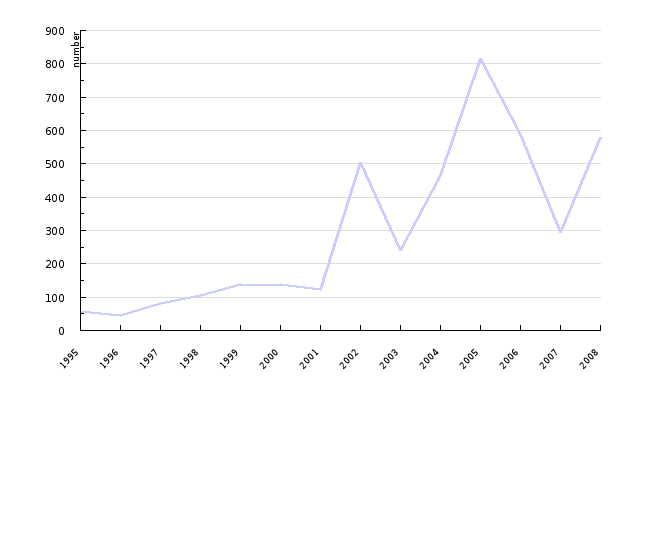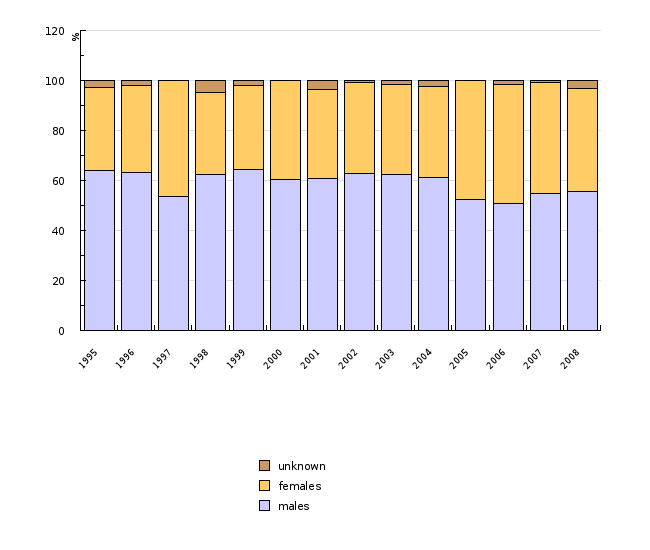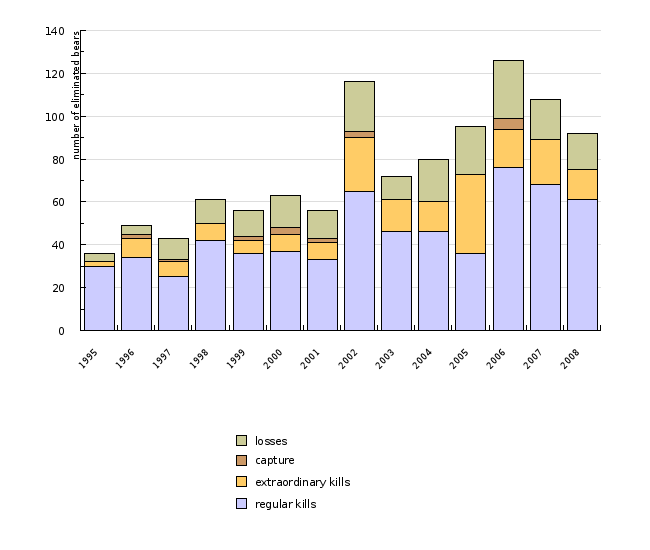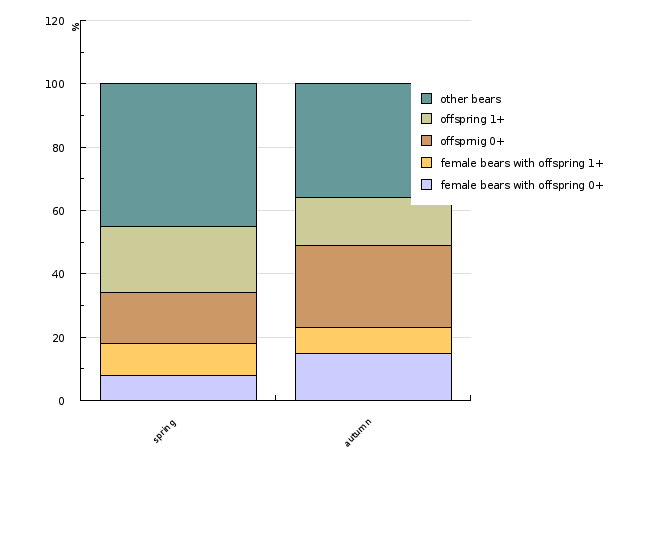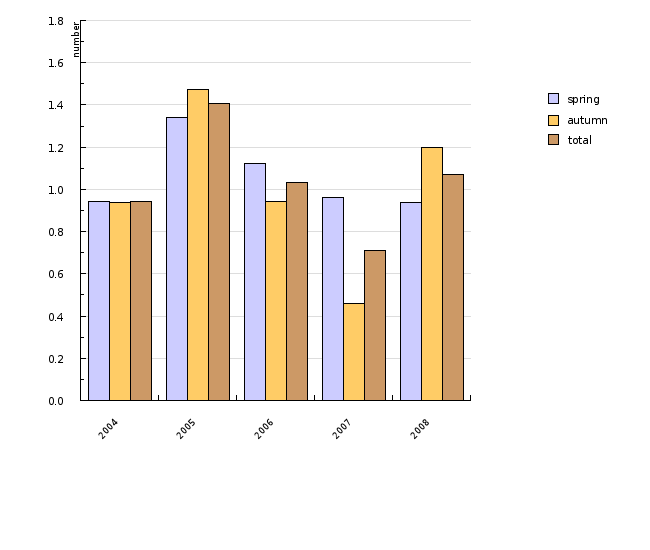[NB06] Brown bear

Key message

The population of the brown bear (Ursus arctos) in Slovenia forms part of the larger population in the Alps – Dinarides (Dinaric Alps) – Pindus Mountains, one of the larger popularions of the brown bear in Europe. It is estimated to 2,100 – 2,500 specimen. The status of the population in Slovenia has been monitored by the Slovenia Forest Service and is deemed favourable. The brown bear lives in large forest areas; in Slovenia, it is present in high Karst fir and beech foliage, so the indicator indirectly reflects the status of this forestry, included in the Natura 2000 network.
Definition
The indicator accounts for the status of the brown bear population in Slovenia, along with – indirectly at least – the status of the bear's habitat. Several sub-indicators touch upon: gender structure of specimen taken from the wild, various reasons for taking specimen from the wild, registration of damage to property caused by bear, and data gathered at permanent counting points.
Data have been collected by the Slovenia Forest Service in accordance with a unified methodology since 1995, while animal observation at permanent counting points have been collected since 2003. If differences measured are in the same manner over a longer time period, their past trend sufficiently demonstrates the indicator's state.
Charts
Statistical data on incidents caused by the brown bear to human assets, Slovenia Forest Service, 2007, Environmental Agency of the Republic of Slovenia, 2008
| 1995 | 1996 | 1997 | 1998 | 1999 | 2000 | 2001 | 2002 | 2003 | 2004 | ||
|---|---|---|---|---|---|---|---|---|---|---|---|
| incidents | number | 57 | 45 | 81 | 105 | 138 | 139 | 123 | 503 | 239 | 466 |
| damage in EUR | EUR | 11795 | 25621 | 40580 | 120653 | 99825 | 52638 | 44240 | 131377 | 64922 | 124129 |
| 2005 | 2006 | 2007 | 2008 | ||||||||
| incidents | number | 817 | 589 | 294 | 579 | ||||||
| damage in EUR | EUR | 194866 | 145160 | 81866 | 171353 |
Statistical data on structure of elimination from the brown bear population, Slovenia Forest Service, 2009.
| 1995 | 1996 | 1997 | 1998 | 1999 | 2000 | 2001 | 2002 | 2003 | 2004 | ||
|---|---|---|---|---|---|---|---|---|---|---|---|
| males | number | 23 | 31 | 23 | 38 | 36 | 38 | 34 | 73 | 45 | 49 |
| females | number | 12 | 17 | 20 | 20 | 19 | 25 | 20 | 42 | 26 | 29 |
| unknown | number | 1 | 1 | 0 | 3 | 1 | 0 | 2 | 1 | 1 | 2 |
| males | % | 63.9 | 63.3 | 53.5 | 62.3 | 64.3 | 60.3 | 60.7 | 62.9 | 62.5 | 61.3 |
| females | % | 33.3 | 34.7 | 46.5 | 32.8 | 33.9 | 39.7 | 35.7 | 36.2 | 36.1 | 36.3 |
| unknown | % | 2.8 | 2 | 0 | 4.9 | 1.8 | 0 | 3.6 | 0.9 | 1.4 | 2.5 |
| up to 100 kg | number | 17 | 29 | 28 | 32 | 37 | 41 | 33 | 86 | 53 | 52 |
| from 101 to 150 kg | number | 12 | 15 | 13 | 20 | 7 | 16 | 14 | 20 | 13 | 17 |
| above 150 kg | number | 6 | 5 | 2 | 8 | 11 | 6 | 7 | 9 | 6 | 9 |
| unknown | number | 1 | np | np | 1 | 1 | np | 2 | 1 | np | 2 |
| total | number | 36 | 49 | 43 | 61 | 56 | 63 | 56 | 116 | 72 | 80 |
| 2005 | 2006 | 2007 | 2008 | ||||||||
| males | number | 50 | 64 | 59 | 51 | ||||||
| females | number | 45 | 60 | 48 | 38 | ||||||
| unknown | number | 0 | 2 | 1 | 3 | ||||||
| males | % | 52.6 | 50.8 | 54.6 | 55.4 | ||||||
| females | % | 47.4 | 47.6 | 44.4 | 41.3 | ||||||
| unknown | % | 0 | 1.6 | 0.9 | 3.3 | ||||||
| up to 100 kg | number | 69 | 81 | 72 | 65 | ||||||
| from 101 to 150 kg | number | 22 | 32 | 21 | 21 | ||||||
| above 150 kg | number | 4 | 13 | 15 | 5 | ||||||
| unknown | number | np | np | np | 1 | ||||||
| total | number | 95 | 126 | 108 | 92 |
Statistical data on the structure of elimination from the brown bear population, Slovenia Forest Service, 2009.
| 1995 | 1996 | 1997 | 1998 | 1999 | 2000 | 2001 | 2002 | 2003 | 2004 | ||
|---|---|---|---|---|---|---|---|---|---|---|---|
| regular kills | number | 30 | 34 | 25 | 42 | 36 | 37 | 33 | 65 | 46 | 46 |
| extraordinary kills | number | 2 | 9 | 7 | 8 | 6 | 8 | 8 | 25 | 15 | 14 |
| capture | number | 2 | 1 | 2 | 3 | 2 | 3 | ||||
| losses | number | 4 | 4 | 10 | 11 | 12 | 15 | 13 | 23 | 11 | 20 |
| kills - total | number | 32 | 43 | 32 | 50 | 42 | 45 | 41 | 90 | 61 | 60 |
| eliminated bears - total | number | 36 | 49 | 43 | 61 | 56 | 63 | 56 | 116 | 72 | 80 |
| 2005 | 2006 | 2007 | 2008 | ||||||||
| regular kills | number | 36 | 76 | 68 | 61 | ||||||
| extraordinary kills | number | 37 | 18 | 21 | 14 | ||||||
| capture | number | 5 | |||||||||
| losses | number | 22 | 27 | 19 | 17 | ||||||
| kills - total | number | 73 | 94 | 89 | 75 | ||||||
| eliminated bears - total | number | 95 | 126 | 108 | 92 |
Statistical data on the monitoring of abundance trends and the population structure of the brown bear, Slovenia Forest Service and Slovenian Hunting Association, 2009.
| spring | autumn | ||
|---|---|---|---|
| female bears with offspring 0+ | % | 8 | 15 |
| female bears with offspring 1+ | % | 10 | 8 |
| offsprnig 0+ | % | 16 | 26 |
| offspring 1+ | % | 21 | 15 |
| other bears | % | 45 | 36 |
Statistical data on the monitoring of abundance trends and the population structure of the brown bear, Slovenia Forest Service and Slovenian Hunting Association, 2009.
| 2004 | 2005 | 2006 | 2007 | 2008 | ||
|---|---|---|---|---|---|---|
| spring | number | 0.94 | 1.34 | 1.12 | 0.96 | 0.94 |
| autumn | number | 0.94 | 1.48 | 0.94 | 0.46 | 1.2 |
| total | number | 0.94 | 1.41 | 1.03 | 0.71 | 1.07 |
Goals
The objective, as determined by the Resolution on National Environmental Action Plan 2005-2012, is to maintain a favourable state of the brown bear population and to decrease conflicts.
Comment
The brown bear (Ursus arctos) population in Slovenia forms part of a population living in the Alps-Dinarides-Pindus mountain range area and which constitutes one of the largest populations in Europe. Its abundance is estimated at roughly 2,100–2,500 specimen. Based on the monitoring of the population state, the Slovenia Forest Service estimates that the population in Slovenia is in a favourable state and comprises of 500–700 specimen.
The brown bear has been included into the Red List of endangered animal species and is classified into category E (endangered species). It is protected by Slovenian, European and international legislation, which specify the obligation to monitor the state of species preservation with special attention paid to priority species. The brown bear has been defined as a priority species.
Slovenia has been monitoring the state of the bear population since 2003 on the basis of regular brown bear counting within a network of permanent counting points (3x yearly at 167 points) during full moon and on the basis of recorded signs of the brown bear's presence in hunting reserves with a special purpose. The average number of bears observed per counting point rose from 2004 until 2005 and subsequently began to fall, only to start rising again in 2008. This indicator was monitored for too short of a period to allow us to determine a trend for the brown bear population in Slovenia. Gender and age structure monitoring at the spring and autumn counting shows that in autumn the Slovenian brown bear population comprises at least 15% female bears, which on average maintain 1.82 cubs of up to 1 year of age. During the same period, the cubs in the first year of age account for 26% and offspring in the second life period for 15% of the entire population (in total, offspring thus represent 41% of the whole population).
Biotechnical Faculty has completed two researches about the brown bear in Slovenia in 2008. Research has gained a lot of vital information on the brown bear, including the assessment of the state population. The researchers estimated the number of population on the basis of age set out by grinding the teeth of bears taken from nature. The population of bears in 1998 reached about 290 specimens and gradually increased until 2006, when estimated at around 370 specimens. After that a decline in the estimated abundance happened in 2008 to around 320 specimens. The reason for the growth of the population abundance, according to researchers, was high fertility and partly also the flow of individuals from the Croatian part of the population. The molecular genetic research achieved at the end of 2007 has reported that there are 354 different bears (159 males and 195 females) in the Slovenian part of the population. On the basis of the aforementioned data, with using method of modeling the catch – marking – recapture for all bear species range, was prepared estimation of their abundance, which ranged between 394 and 475 brown bears (according to the 95-percent confidence level).
Damage caused to human property by the brown bear is determined by authorised damage inspectors, i.e. the Slovenia Forest Service staff. Data have been recorded since 1995. During this period the damage monitoring and compensation payment system has been altered a few times. The subindicator is therefore not necessarily directly linked to the abundance of the brown bear population. The Ministry of the Environment and Spatial Planning took over the compensation payments in 2005 and the payments have since then been recorded in accordance with a unified methodology.
Management of the brown bear population is based on the Strategy for the management of brown bear (Ursus arctos) in Slovenia, which was adopted by the Government of the Republic of Slovenia in January 2002, and the related Brown bear (Ursus Arctos L.) management action plan in the Republic of Slovenia. In the Strategy, animal elimination from the wild as one of the management measures is divided into: kills of a certain number of bears to ensure harmony with man, extraordinary kills of bears which pose a direct threat to man and his assets, capture of living bears for settlement in nature or relocation to another place in nature, capture of lone cubs or injured animals as well as loss due to animals being run over or any other cause of death. Data on bear elimination from the wild have been kept by the Slovenia Forest Service since 1995. The trend of eliminating the brown bear from the population has risen between 1995 and 2008. Regular harvest represents on average 60%, extraordinary harvest 18%, losses 20% and other reasons account for 2% of cases of taking the brown bears from nature. Between 1995 and 2008, 40% of bears eliminated from the population were males and 60% were females. Such a ratio implies a deviation from the natural gender structure, since the ratio at birth is normally 1:1, and contributes to a higher natality of the population.
Methodology
Data for Slovenia
Objectives summarized by: the Resolution on National Environmental Action Plan 2005-2012 (ReNPVO), Official Gazette of the Republic of Slovenia, 2/06, and the Strategy for the management of brown bear (Ursus arctos) in Slovenia (adopted on 24 January 2002 by the Government of the Republic of Slovenia).
Source database or source: Statistical data on the monitoring of abundance trends and the population structure of the brown bear, Slovenia Forest Service; Statistical data on structure of elimination from the brown bear population, Slovenia Forest Service; Statistical data on incidents caused by the brown bear to human assets, Slovenia Forest Service; ODSEV – Register of claims for compensation for damage, Environmental Agency of the Republic of Slovenia
Data administrator: Slovenia Forest Service, Environmental Agency of the Republic of Slovenia
Data acquisition date for this indicator for the indicator: 25 November 2009
Methodology and frequency of data collection for the indicator:Statistical data on the brown bear population include data on the reasons for taking bears from nature, and the gender and weight of specimen eliminated from nature. Data has been collected since 1995. Data on the size and structure of the population are gathered annually through observations at 167 permanent counting points. Females with cubs, cubs and adult bears are recorded twice a year.
Data processing methodology: Data is represented in diagrams and tables, and relevant shares are calculated to ensure higher transparency and clarity.
Information concerning data quality:
- Advantages and disadvantages of the indicator: Official data is used as applied in the annual designation of the number of brown bears to be eliminated from nature by harvest, pursuant to Article 7a of the Decree on protected wild animal species.
- Relevance, accuracy, robustness, uncertainty:
Reliability of the indicator (archive data): Data is reliable.
Uncertainty of the indicator (scenarios/projections): Not applicable to the indicator.
- Overall assessment (1 = no major comments, 3 = data to be considered with reservation)
Relevance: 1
Accuracy: 1
Completeness over time: 1
Completeness over space: 1
Other sources and literature:
- Statistična baza odvzema, škod in štetij na stalnih števnih mestih. Zavod za gozdove Slovenije, Lovska zveze Slovenije. (Statistical database on elimination, damage and counting at permanent counting points. Slovenia Forest Service, Hunters Association of Slovenia).
- Strokovno mnenje za odstrel velikih zveri v letu 2009. Zavod za gozdove Slovenije, januar 2009. (Expert opinion on harvest of large beasts in 2009. Slovenia Forest Service, January 2009).
- Jerina, K., Adamič, M., Marenče, M., Jonozovič, M., 2003. Development of a brown bear population management plan. LIFE Natura III project.
- ODSEV – evidenca odškodninskih zahtevkov, Agencija RS za okolje, 2008. Skrbnik: Petra Ulamec. Splet: http://sirena.arso.gov.si/odsev/ (ODSEV – Register of claims for compensation for damage, Environmental Agency of the Republic of Slovenia, 2008. Administrator: Petra Ulamec. website: http://sirena.arso.gov.si/odsev/).
- Jerina, K., Adamič, M. 2007. Analiza odvzetih rjavih medvedov iz narave v Sloveniji v obdobju 2003–2006 na podlagi starosti, določene z brušenjem zob. Univerza v Ljubljani, Biotehniška fakulteta, Oddelek za gozdarstvo in obnovljive gozdne vire.
- Kos, I. s sodelavci 2008. Analiza medvedov, odvzetih iz narave, in genetsko-molekularne raziskave populacije medveda v Sloveniji. Univerza v Ljubljani, Biotehniška fakulteta, Oddelek za biologijo.









